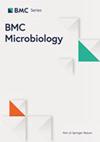Biocompatibility and photoinactivation evaluation of zinc hydroxide chloride nanosheets against Streptococcus mutans.
IF 4
2区 生物学
Q2 MICROBIOLOGY
Shima Afrasiabi, Fatemeh Saghatchi, Ahmad Reza Dehpour, Ramin Goudarzi, Mohammad Reza Karimi, Alireza Partoazar
下载PDF
{"title":"Biocompatibility and photoinactivation evaluation of zinc hydroxide chloride nanosheets against Streptococcus mutans.","authors":"Shima Afrasiabi, Fatemeh Saghatchi, Ahmad Reza Dehpour, Ramin Goudarzi, Mohammad Reza Karimi, Alireza Partoazar","doi":"10.1186/s12866-025-03822-x","DOIUrl":null,"url":null,"abstract":"<p><strong>Background: </strong>Considering the efficacy of antimicrobial photodynamic therapy (PDT) in inactivating bacteria, this study reports that zinc hydroxide chloride nanosheets (ZHC-NSs) are useful for this purpose.</p><p><strong>Materials & methods: </strong>The characterization of ZHC-NSs was performed using microscopic and spectroscopic techniques. The irritation test, acute toxicity test, and genotoxicity test of ZHC-NSs were evaluated and their effects on human pulp fibroblast cells (HPFC) viability, intracellular reactive oxygen species (ROS) levels, and antibacterial activity of ZHC-NSs (1-8 mg ml<sup>-1</sup>) alone or in light conditions were investigated.</p><p><strong>Results: </strong>The ZHC-NSs structure showed a crystalline form and their sheets' thickness had an average size of 129.6 ± 19.50 nm. ZHC-NSs did not severely damage internal organs and were not genotoxic. The cytotoxic effect of ZHC-NSs on HPFC was concentration-dependent so that ZHC-NSs at higher concentrations (4 and 8 mg ml<sup>-1</sup>) killed half of the HPFC cells. When ZHC-NSs were used in combination with a 980 nm diode laser, namely ZHC-NS<sup>©</sup>, ROS production increased and led to enhanced antibacterial activity against Streptococcus mutans in planktonic and biofilm form. A statistically significant difference was found between ZHC-NSs without laser irradiation and photoexcited ZHC-NSs.</p><p><strong>Conclusion: </strong>ZHC-NSs<sup>©</sup> with the potential ability to produce ROS could be effective in complementary treatment against S. mutans.</p>","PeriodicalId":9233,"journal":{"name":"BMC Microbiology","volume":"25 1","pages":"116"},"PeriodicalIF":4.0000,"publicationDate":"2025-03-04","publicationTypes":"Journal Article","fieldsOfStudy":null,"isOpenAccess":false,"openAccessPdf":"https://www.ncbi.nlm.nih.gov/pmc/articles/PMC11877797/pdf/","citationCount":"0","resultStr":null,"platform":"Semanticscholar","paperid":null,"PeriodicalName":"BMC Microbiology","FirstCategoryId":"99","ListUrlMain":"https://doi.org/10.1186/s12866-025-03822-x","RegionNum":2,"RegionCategory":"生物学","ArticlePicture":[],"TitleCN":null,"AbstractTextCN":null,"PMCID":null,"EPubDate":"","PubModel":"","JCR":"Q2","JCRName":"MICROBIOLOGY","Score":null,"Total":0}
引用次数: 0
引用
批量引用
Abstract
Background: Considering the efficacy of antimicrobial photodynamic therapy (PDT) in inactivating bacteria, this study reports that zinc hydroxide chloride nanosheets (ZHC-NSs) are useful for this purpose.
Materials & methods: The characterization of ZHC-NSs was performed using microscopic and spectroscopic techniques. The irritation test, acute toxicity test, and genotoxicity test of ZHC-NSs were evaluated and their effects on human pulp fibroblast cells (HPFC) viability, intracellular reactive oxygen species (ROS) levels, and antibacterial activity of ZHC-NSs (1-8 mg ml-1 ) alone or in light conditions were investigated.
Results: The ZHC-NSs structure showed a crystalline form and their sheets' thickness had an average size of 129.6 ± 19.50 nm. ZHC-NSs did not severely damage internal organs and were not genotoxic. The cytotoxic effect of ZHC-NSs on HPFC was concentration-dependent so that ZHC-NSs at higher concentrations (4 and 8 mg ml-1 ) killed half of the HPFC cells. When ZHC-NSs were used in combination with a 980 nm diode laser, namely ZHC-NS© , ROS production increased and led to enhanced antibacterial activity against Streptococcus mutans in planktonic and biofilm form. A statistically significant difference was found between ZHC-NSs without laser irradiation and photoexcited ZHC-NSs.
Conclusion: ZHC-NSs© with the potential ability to produce ROS could be effective in complementary treatment against S. mutans.
氢氧化锌纳米片抗变形链球菌的生物相容性和光失活评价。
背景:考虑到抗菌光动力疗法(PDT)灭活细菌的效果,本研究报道了氢氧化锌氯纳米片(ZHC-NSs)在这方面的作用。材料与方法:采用显微和光谱技术对ZHC-NSs进行表征。研究了ZHC-NSs (1 ~ 8 mg ml-1)对人牙髓成纤维细胞(HPFC)活力、细胞内活性氧(ROS)水平及在光照条件下的抗菌活性的影响。结果:ZHC-NSs结构呈结晶状,薄片厚度平均为129.6±19.50 nm。ZHC-NSs对内脏无严重损害,无遗传毒性。ZHC-NSs对HPFC的细胞毒作用呈浓度依赖性,高浓度(4和8 mg ml-1)的ZHC-NSs杀死了一半的HPFC细胞。当ZHC-NS与980 nm二极管激光器(即ZHC-NS©)联合使用时,ROS的产生增加,导致对浮游和生物膜形式的变形链球菌的抗菌活性增强。未经激光照射的ZHC-NSs与光激发的ZHC-NSs相比,差异有统计学意义。结论:ZHC-NSs©具有潜在的ROS生成能力,可有效补充治疗变形链球菌。
本文章由计算机程序翻译,如有差异,请以英文原文为准。
来源期刊
期刊介绍:
BMC Microbiology is an open access, peer-reviewed journal that considers articles on analytical and functional studies of prokaryotic and eukaryotic microorganisms, viruses and small parasites, as well as host and therapeutic responses to them and their interaction with the environment.

 求助内容:
求助内容: 应助结果提醒方式:
应助结果提醒方式:


